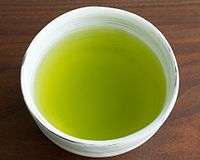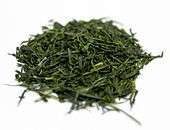Sencha
| Sencha 煎茶 | |
|---|---|
 | |
| Type | Green |
|
| |
| Other names | Steeped Tea |
| Origin | Japan |
|
| |
| Quick description | Very popular in Japan. |
|
| |
| Temperature | 80°C / 176°F[1] |
| Time | 1 min |
| Quantity | 1.5 tablespoons (7-8 grams) per litre |

Sencha (煎茶) is a type of Japanese ryokucha (緑茶, green tea) which is prepared by infusing the processed whole tea leaves in hot water. It is the most popular tea in Japan. This is as opposed to matcha (抹茶), powdered Japanese green tea, where the green tea powder is mixed with hot water and therefore the leaf itself is included in the beverage.
Overview
Among the types of Japanese green tea prepared by infusion, "sencha" is distinguished from such specific types as gyokuro and bancha. It is the most popular tea in Japan, representing about 80 percent of the tea produced in Japan.[2]
The flavour depends upon the season and place where it is produced, but shincha, or "new tea" from the first flush of the year, is considered the most delicious. Tea-picking in Japan begins in the south, gradually moving north with the spring warmth. During the winter, tea plants store nutrients, and the tender new leaves which sprout in the spring contain concentrated nutrients. Shincha represents these tender new leaves. The shincha season, depending upon the region of the plantation, is from early April to late May, specifically the 88th day after Setsubun which usually falls around February 4, a cross-quarter day traditionally considered the start of spring in Japan. Setsubun or Risshun is the beginning of the sexagenary cycle; therefore, by drinking sencha one can enjoy a year of good health.[3]
The ideal colour of the sencha beverage is a greenish golden colour. Depending upon the temperature of the water in which it is decocted, the flavour will be different, adding to the appeal of sencha. With relatively more temperate water, it is relatively mellow; with hot water, it is more astringent.[4] Unground tea was brought from China after matcha (抹茶, powdered green tea). Some varieties expand when steeped to resemble leaf vegetable greens in smell, appearance, and taste.
The tea production process by which sencha and other Japanese ryokucha (緑茶, green tea) are created differs from Chinese green teas, which are initially pan-fired. Japanese green tea is first steamed for between 15–20 seconds to prevent oxidization of the leaves. Then, the leaves are rolled, shaped, and dried. This step creates the customary thin cylindrical shape of the tea. Finally, the leaves are sorted and divided into differing quality groups.[5]
The initial steaming step imparts a difference in the flavour between Chinese and Japanese green tea, with Japanese green tea having a more vegetal, almost grassy flavour (some taste seaweed-like). Infusions from sencha and other green teas that are steamed (like most common Japanese green teas) are also greener in colour and slightly more bitter than Chinese-style green teas.
Types of sencha
- Jô Sencha (上煎茶), superior sencha
- Toku Jô Sencha (特上煎茶), extra superior sencha
- Hachijuhachiya Sencha (八十八夜), sencha harvested after 88 days (respectively nights) after Spring begins (risshun)
- Kabuse Sencha or Kabusecha (かぶせ茶), covered sencha
- Asamushi (浅蒸し), lightly steamed sencha
- Chumushi, middle steamed (30-90s)
- Fukamushi or fukamushicha (深蒸し), deeply steamed sencha - 1–2 minutes
- Shincha (新茶) or Ichibancha (一番茶), first-picked sencha of the year [6]
Shincha

Shincha (新茶), "new tea", represents the first month's harvest of sencha. Basically, it is the same as ichibancha (一番茶), "the first-picked tea," and is characterized by its fresh aroma and sweetness. "Ichibancha" distinguishes "shincha" from both "nibancha" ("the second-picked tea") and "sanbancha" ("the third-picked tea"). Use of the term "shincha" makes emphatically clear that this tea is the year's earliest, the first tea of the season.[7] The opposite term is kocha (古茶), or "old tea," referring to tea left over from the previous year.[8] Besides the fresh aroma of the young leaves, shincha is characterized by its relatively low content of bitter catechin and caffeine, and relatively high content of amino acid.[9] Shincha is available only for a limited time. The earliest batch, from southern Japan, comes on the market around late April through May. It is popular in Japan, but is available in only limited amounts outside Japan. It is prized for its high vitamin content, sweetness, and grassy flavour with resinous aroma and minimal astringency.
Kabusecha
Kabusecha (冠茶) is sencha grown in the shade to increase sweetness and relaxing amino acids.[10] About a week before the tea leaf buds are picked in the spring, the plantation is covered with a screen to cut out the direct sunlight. This shading produces a milder tea than standard sencha. The shaded tea known as gyokuro differs from kabusecha in that it is shaded for a longer period: about 20 days.[11]
Special nets (kabuse) are hung over the plants to obtain a natural shade without completely blocking out sunlight. Kabusecha Sencha has a mellower flavour and more subtle colour than Sencha grown in direct sunlight.
Sencha tea ceremony
Senchadō (The Way of Sencha): Like the formal art surrounding matcha, there is a formal art surrounding sencha, which is distinguished as senchadō (煎茶道). Generally it involves the high-grade gyokuro class of sencha.
See also
- List of Japanese teas
- Baisao — regarded as the first sencha master
References
- ↑ How to Prepare Sencha by Ippodo Tea
- ↑ Mary Lou Heiss, Robert J. Heiss (23 Mar 2011). The Story of Tea: A Cultural History and Drinking Guide. Random House LLC. p. 182.
- ↑ Itoen HP site about shincha
- ↑ Japanese website on "What is Sencha?"
- ↑ Illustrated explanation of standard production process for sencha
- ↑ Types of sencha http://teapedia.org/en/Sencha
- ↑ Itoen Japanese HP site about shincha at http://ocha.tv/varieties/nihoncha_varieties/varieties_shincha/
- ↑ Japanese Kojien dictionary, entry for "kocha."
- ↑ Itoen HP site about shincha
- ↑ Mary Lou Heiss, Robert J. Heiss (23 Mar 2011). The Story of Tea: A Cultural History and Drinking Guide. Random House LLC. p. 183.
- ↑ Explanation of sencha, gyokuro, and kabusecha differences (Japanese)